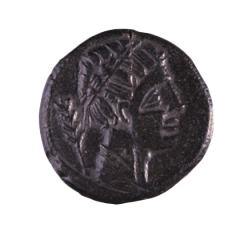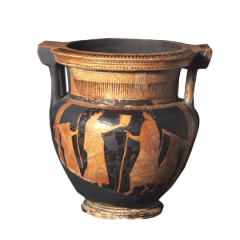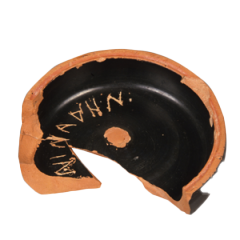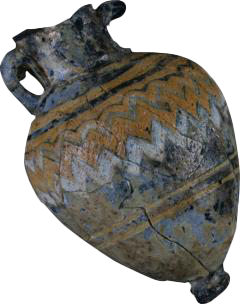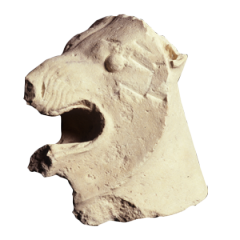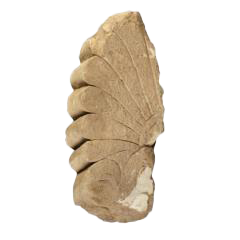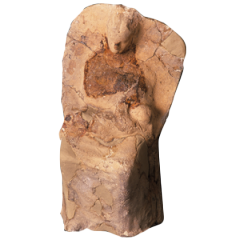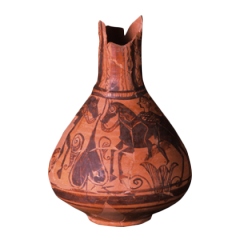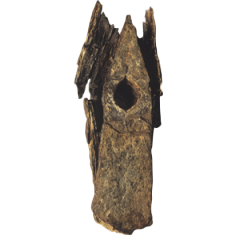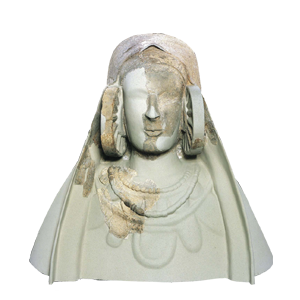
Falcata
Necropolis of Cabezo Lucero (Guardamar del Segura, Alicante) Iron h: 57 cm; w: 7 cm; d: 1.5 cm Iberian Second quarter of the 4th century BC.
Falcata - curved sword - with a hilt in the shape of a bird's head. It is made of wrought and beaten iron, with a double-edged blade at the tip, a fragment of which is missing. Parallel longitudinal grooves are insinuated on the blade. It has a rivet on the hilt, as well as clamps attached to the spine and two suspension rings.
The falcata is the most representative weapon of the Iberians, especially in Contestania, and is frequently found in burial sites. The rich ornamentation they usually have indicates that, in addition to their military use, they were elements of prestige and an indication of the social status of the person in whose grave they were deposited. In addition to their presence in tombs, falcatas are represented in sculpture and in the decoration of Iberian ceramics.
This piece belongs to the burial site catalogued as point 36 of the Cabezo Lucero Necropolis.
C.S.: 5723
ARANEGUI ET AL., 1993, 197 f., fig. 39.1.
CABRÉ, Mª E., 1934.
QUESADA SANZ, F., 1997.
VV.AA., 1992.
Outstanding pieces in the Iberian Hall
- ................................................. Bronze ace from the Iberian mint of Saiti (Xàtiva, Valencia). Type Vives 20-2.
- ................................................. Necropolis of El Cabezo Lucero (Guardamar del Segura) Ceramic h: 34'5cm; w: 29'5 cm Iberian 460-450 BC.
- ................................................. Illeta dels Banyets (El Campello) Ceramic h: 11.2 cm; w: 11.2 cm; d: 2.9 cm Iberian. 380-325 BC.
- ................................................. Necropolis of Cabezo Lucero (Guardamar del Segura) Vitreous paste h: 6.5 cm; w: 4.1 cm: 4'1 cm Ancient Iberian Late 5th century BC.
- ................................................. Necropolis of Cabezo Lucero (Guardamar del Segura, Alicante) Limestone h: 27.5 cm; w: 19 cm; d: 23 cm Iberian Second half of the 5th century - beginning of the 4th century BC.
- ................................................. Necropolis of Cabezo Lucero (Guardamar del Segura)
- ................................................. Necropolis of Cabezo Lucero (Guardamar del Segura) Limestone h: 18.5 cm; w: 8.5 cm; d: 5.3 cm Ancient Iberian-Pliocene Second half of the 5th century-early 4th century BC.
- ................................................. DEMETER-LIKE MOTHER-GODDESS Necropolis of La Albufereta (Alicante) Ceramic made with a univalve mould h: 21 cm; w: 11.3 cm; h: 7.5 cm Iberian 4th century BC.
- Terracotta bust ................................................. Necropolis of La Albufereta (Alicante) Terracotta h: 40 cm; w: 37 cm; d: 21.5 cm Iberian 4th-3rd century BC: 37 cm; w: 21'5 cm Iberian 4th-3rd century BC.
- ................................................. Tossal de Manises (Alicante) Ceramic h: 31.5 cm; w: 21.4 cm Iberian Late 3rd century BC.
- ............................................. La Escuera (San Fulgencio) Iron h: 30 cm; w: 11.4 cm; h: 13.8 cm Iberian 3rd century BC.
- ................................................. Necropolis of Cabezo Lucero (Guardamar del Segura, Alicante) Sandstone) Sandstone h: 49 cm; w: 54 cm; d: 33 cm Iberian Late 5th century BC, early 4th century BC.
- ................................................ Necropolis of Cabezo Lucero (Guardamar del Segura, Alicante) Iron h: 57 cm; w: 7 cm; d: 1.5 cm Iberian Second quarter of the 4th century BC.

